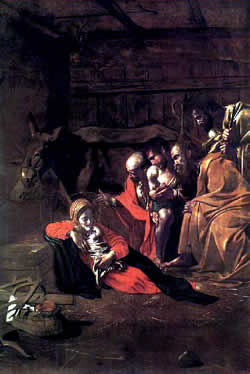
The uncompromisingly realistic depiction of the Holy Family, together with a sensually effective chiaroscuro, are typical of Caravaggio. The dramaticality and the expressionist theatrical gestures remind the observer of a stage scene. God's birth into a world of poverty is marked as an event paradoxically both common and sensational. There is no manger. The reclining figure of Mary, who seems weakened, holds the Child in a close embrace. Joseph, aside, forms a group with the overawed shepherds, who hesitate to approach the mater et virgo. Again, each realistic detail serves to underline the religious content of the picture. Mary's scarlet cloak and her posture prefiguring the pietà, the napkin as a prefiguration of the shroud, and the empty feeding trough that suggests the empty grave on Easter morning, hint at Christ's later Passion. The corn of wheat and the severed stone are symbols of Christ, and the wicker basket with its loaf of "living bread" also contains carpenter's tools, which, as instruments of torture, again prefigure the passion of Christ.